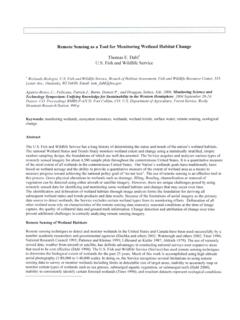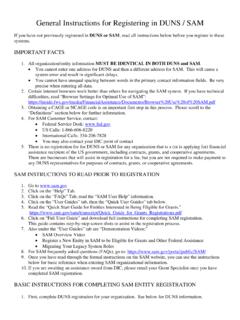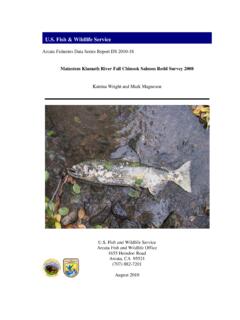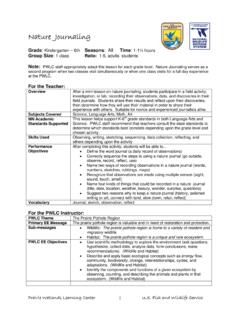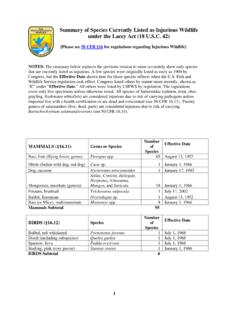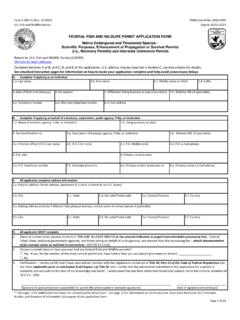Transcription of Where are they from & Where are they now?
1 Asian Carp What are they? The term Asian Carp refers to fish in the Cyprinid family such as goldfish, koi, and common carp. Don t worry; your pet goldfish isn t an In the aquatic nuisance species world, the term Asian carp specifically refers to four species of introduced carp that pose a significant threat to the freshwater aquatic environment: bighead carp (Hypophthalmichthys nobilis), silver carp (H. molitrix), black carp (Mylopharyngodon piceus), and grass carp (Ctenopharyngodon idella). Although they will inhabit lakes and ponds, Asian carp prefer large slow moving rivers with high turbidity, moderate to low oxygen levels and warmer water temperatures (up to 86 F).
2 FACT: In many Asian cultures, the carp is a symbol of prosperity and longevity. What do they look like? The bighead carp, named after its large scaleless noggin, is identified by numerous dark blotches on its sides, large mouth, and lower jaw that extends past the upper jaw (think bulldog, but with more slime). Its eyes are situated very low on its head and generally look downward. Pharyngeal teeth (see Side Note) are long and rounded, and gill rakers are set very close together to facilitate water filtration. As an adult, this brute can grow up to 4 feet in length and weigh over 100 pounds. A Side Note: Asian carp do not have traditional teeth on their jaws.
3 They have what are called pharyngeal teeth or throat teeth. Technically these teeth don t grow out of the throat (that would be weird), they are attached to the gill arches the same bony supports that serve as attachment points for gill filaments and gill rakers. Carp pharyngeal teeth come in many sizes and shapes, depending on the diet of the fish. Pharyngeal TeethThe silver carp has a very uniform coloration that changes from bright silver as a juvenile to a more greenish hue as an adult. The head of silver carp is also scaleless with a big upturned mouth and large eyes that are low on the head looking slightly downward.
4 Gill rakers are thin and fused together into a sponge like structure for filtering plankton, and pharyngeal teeth have striated surfaces. Considered the shrimp of the bunch, this guy can grow up to 4 feet in length and can weigh 75 100 ponds. The grass carp has an oblong body shape compared to the laterally compressed (flattened from side to side) bodies of the other carp species. Body coloration is dark silvery grey above with light gold sides and a white belly. Scales of grass carp are very large and are said to resemble the pattern of a chain link fence. The head of grass carp is broad with long serrated pharyngeal teeth specialized for eating aquatic vegetation.
5 This whopper of a fish can grow up to 5 feet in length and can weigh an amazing 143 pounds. The black carp looks very similar to the grass carp, but has an overall black brown coloration and blackish grey fins. The body of the black carp is laterally compressed and covered with large black tipped scales, giving the fish a cross hatched appearance. Pharyngeal teeth of black carp resemble human molars and are used to crush the shells of snails and mollusks. This goliath can also grow up to 5 feet in length and weigh an unbelievable 150 pounds. FACT: Asian carp can eat an astounding 5 40% of its body weight each day.
6 Where are they from & Where are they now? Asian carp are native to you guessed it, Asia, from southern china north into eastern Russia, and possibly northern Vietnam. Asian carp were first introduced into the southern United States in the early 1960s and 70s. By the 1980s, three of the four species had escaped and/or spread into local water bodies. Today Asian carp have spread throughout the Mississippi, Ohio, Missouri, and Illinois rivers and their tributaries. bighead carp are currently present in 23 states (including California), silver carp are present in 17 states, black carp have been reported along the lower Mississippi basin, but current distribution and abundance is unknown, and grass carp, the most widely distributed Asian carp species can now be found in 45 states including California, Oregon and Washington.
7 Currently there are no known breeding populations of invasive Asian Carp on the west coast let s keep it that way! The maps below depict states with Asian carp presence as of 2011. FACT: In some areas of the Mississippi basin Asian carp comprise up to 97% of fish biomass. How did they get here and how are they spread? Asian carp were brought into the United States intentionally by humans to capitalize on the carps dietary preferences. bighead , silver and grass carp were first introduced to control nuisance algae blooms and aquatic vegetation in aquaculture facilities, farm ponds and sewage lagoons. Black carp were introduced to control a parasite hosting snail commonly found in aquaculture facilities.
8 This relationship worked well until Mother Nature and a few unsuspecting humans got in the way. Flood events helped carp escape from private ponds and aquaculture facilities and human activities such as live bait releases, intentional stocking (to create a food source), and the construction of man made canals helped these fishy fugitives on their path to freedom. Once loose, Asian carp spread quickly, reproduced rapidly, and became very VERY abundant. FACT: Depending on its size, female Asian carp can produce up to a million eggs each year. bighead carp silver carp Grass carp Black carp What are their impacts? Asian carp are eating machines!
9 Each fish can consume an astounding 5 40% of its body weight in food each day. Just imagine the impact this can have on the aquatic ecosystem! bighead and silver carp primarily consume phytoplankton and zooplankton, the food base for a number of native invertebrates, freshwater mussels, snails, juvenile and adult fish species. The aptly named grass carp are strict herbivores capable of consuming all aquatic vegetation within a stream as well as vegetation along the stream bank. This aggressive feeding behavior may lead to stream bank erosion, increased water turbidity, siltation of fish spawning grounds, wide swings in water temperature and oxygen levels, a loss of important fish habitat, or a reduction in the food base for organisms such as waterfowl.
10 The foraging habits of black carp can lead to a significant reduction in native freshwater mussel and snail populations, and may lead to a decline in those organisms that depend on mollusks as a food resource such as native fish, turtles, birds, and mammals. Besides their gluttonous dietary habits that damage habitats and deplete important food resources, Asian carp may transmit disease to native fish populations, threaten economically important commercial and sport fisheries, ruin the aesthetic and recreational value of a water body as well as pose a threat to unsuspecting water recreationalists. silver carp spontaneously leap from the water when they feel threatened or hear loud noises such as a boat motor.

